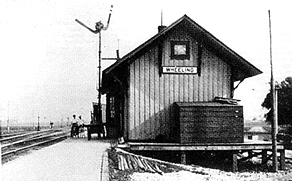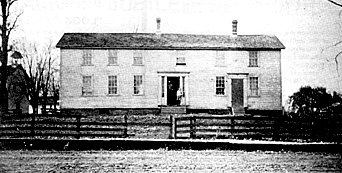
|
|

|

|

|

|

|
Wheeling
| In 1814, the elevation of the Territory of Illinois to state- hood, heralded the end of the existence of the Indians in the state, including the Potawatomi in the area which is now known as Wheeling. There have been many stories written about the methods used to induce the Indians to sign the treaties which deeded their land to the white man, but probably the most honest one is that the Indians were given large quantities of "fire-water" to cloud their judgement. Whatever the reasons or methods used, one fact remains; The Indians did sign treaties, and, in 1833, were ordered to leave the state. Prior to the signing of the treaties, the first white man arrived in the Wheeling area. Little is known as to his background, in fact, there is no record of his first name. He is simply known in the records as "Mr. Sweet." Mr. Sweet arrived in March of 1833, and built a cabin in which he lived for approximately six months. He was apparently on excellent terms with the Indians, because this was prior to the ratification of the treaties and it is known that the Indians were generally opposed to any white man settling on their lands. George Strong moved into the Sweet cabin on the Second of September, after being advised by Col. Thomas Owen, the Indian agent in Chicago, not to do so. Mr. Strong was informed that should he attempt to occupy the land, the United States troops would have to defend the rights of the Indians if any trouble ensued. |
 |
| Wheeling Station as it appeared around 1910. |
| Mr.Strong apparently figured that the treaty would soon be ratified and decided to take the risk. He bought the claim from Mr. Sweet in October, for the sum of Sixty Dollars, and thus became the first permanent white setler in the Wheeling area. Shortly after taking possession of the cabin, Strong was surrounded by approximately a dozen Indians. He went out- side and fought with them, knocking at least one Indian down, and somehow escaped with his life. It is thought that his lack of apparent fear was the thing that saved him. This tenacity and strength of purpose was also present in the character of the other settlers who began to arrive in greater numbers after the ratification of the treaties. After the banishment of the Indians, the greater danger faced by the settlers was that of claim-jumpers. This threat diminished when the legitimate setlers organized to fight the claim-jumpers who generally worked along. |
 |
Wheeling's first Commercial Enterprise was this tavern-hotel, built by Joseph Filkins in 1837. Located on the Northwest corner of Miwaukee and Dundee, this building was the site of Wheeeling's First Post Office and served as a regular coach stop for the stage from Chicago to Milwaukee. This picture was taken in 1905. The building was demolished in 1918. |
| Joseph Filkings built the first residence in the vicinity of Wheeling proper in 1834, and as the surrounding area became more densely populated, a post office was established in 1836, with Mr. Filkins as the first postmaster. This increase in population also presented other problems such as the need for a store where items could be bought that could not be made in the home. Another need was for a meeting place where the men could gather and discuss problems, or just make small talk. Both of these requirements were met in 1837, when Mr. Filkins built the first commercial building, a tavern-hotel. In the same year, Russell Wheeler and Charles Daniels opened a general store. |

|
| Wheeling.com 401 South Milwaukee Avenue Suite 240 Wheeling Illinois 60090 847.777.4567 |
|
| www.wheeling.com | Return to Top | www.wheelingIC.org |
|